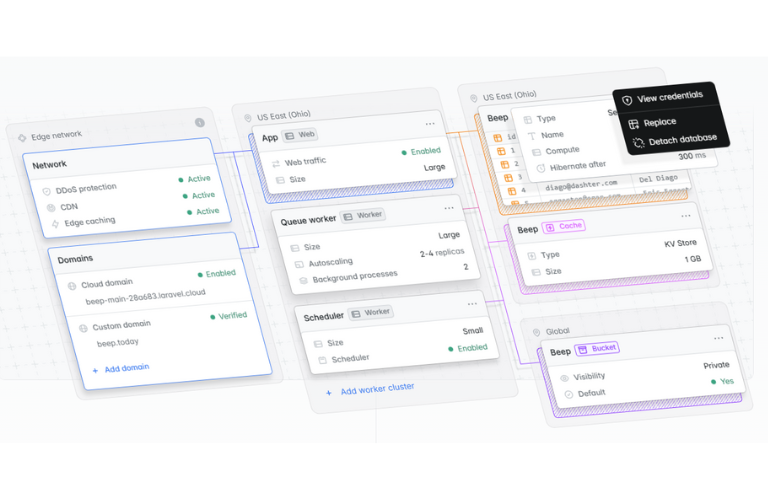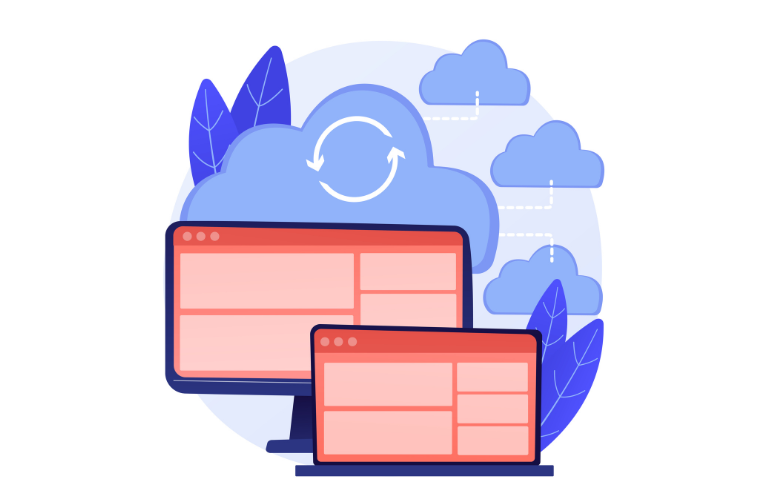Discover how Laravel Cloud simplifies deploying and scaling Laravel apps with managed infrastructure, databases, and zero-downtime updates. Start building faster! With laravel 12 update, it officially launched their own tool of Laravel Cloud. Now this Article contains full details about the laravel Cloud, explore all the details about this.
Table of Contents
What Is Laravel Cloud?
Laravel Cloud is a fully managed infrastructure platform designed exclusively for Laravel applications. It eliminates the complexities of server management, database scaling, and deployment workflows, allowing developers to focus on writing code instead of configuring servers. Whether you’re launching a side project or scaling an enterprise app, Laravel Cloud offers tools to streamline every step—from Git push to global traffic distribution.
With features like auto-scaling databases, Redis-compatible caching, and built-in DDoS protection, Laravel Cloud is the future of Laravel deployment. Let’s explore how it works and why it’s a game-changer.
Why Choose Laravel Cloud?
1. Zero Server Management
Forget SSHing into servers or tweaking NGINX configurations. Laravel Cloud handles:
- Automatic TLS Certificates: Every app gets HTTPS out of the box.
- Global Edge Network: Partnering with Cloudflare, it caches assets and blocks threats at the edge.
- Managed Databases: Spin up Postgres or MySQL clusters in seconds.
2. Git-Driven Deployments
Connect your GitHub, GitLab, or Bitbucket repository, and Laravel Cloud deploys your app automatically on every git push. No manual scripting required.
3. Cost-Effective Scaling
Pay only for what you use. The platform scales resources like CPU and RAM dynamically, so you never overprovision.
Getting Started with Laravel Cloud
Step 1: Create Your Application
- Sign up at Laravel Cloud.
- Link your Git provider (e.g., GitHub) and select your repository.
- Choose a region close to your users for faster performance.
Step 2: Customize Your Environment
Configure PHP versions, environment variables, and add-ons like databases:
// Customize .env variables via the dashboard
APP_ENV=production
CACHE_DRIVER=redis Step 3: Deploy in One Click
Hit Deploy, and Laravel Cloud handles:
- Dependency installation (composer install)
- Asset compilation (npm run build)
- Zero-downtime rollout
Key Features of Laravel Cloud
All env settings you can change from the dashboard, which you can visit in the settings.
Fully Managed Databases
Laravel Cloud supports two database types:
Serverless PostgreSQL
- Auto-Scaling Compute: Set a min/max CPU range (e.g., 0.25–4 units).
- Hibernation: Pause compute during inactivity to save costs.
- Connection Pooling: Handle 10k+ concurrent queries with pgbouncer.
Example configuration:
DB_CONNECTION=pgsql
DB_HOST=your-cluster-pooler.us-east-2.pg.laravel.cloud Managed MySQL
- Fixed Resources: Ideal for predictable workloads.
- Snapshot Backups: Automatic daily backups with 7-day retention.
Redis-Compatible Caching
Attach a key-value store for sessions, queues, or caching:
// Use Redis with Laravel's Cache facade
Cache::put('key', 'value', 3600); S3-Compatible Object Storage
Store user uploads, logs, or static assets using Cloudflare R2:
Install the Flysystem S3 adapter:
composer require league/flysystem-aws-s3-v3 Configure your bucket:
FILESYSTEM_DISK=s3
AWS_BUCKET=your-bucket-name Advanced Use Cases
Real-Time Apps with WebSockets
Integrate Laravel Echo with Pusher or Ably for real-time features:
// resources/js/bootstrap.js
window.Echo = new Echo({
broadcaster: 'pusher',
key: import.meta.env.VITE_PUSHER_APP_KEY
}); Autoscaling for Traffic Spikes
Production-tier plans automatically scale web and worker instances. Adjust settings via the dashboard:
Autoscaling Settings
Monitoring and Logging
Laravel Cloud provides built-in tools to track performance:
- CPU/Memory Metrics: View real-time resource usage.
- Log Search: Filter logs by type (e.g., error, queue).
- Alerting: Set up notifications for critical issues.
# View recent deployment logs
laravel-cloud logs --tail Benefits of Laravel Cloud
Laravel Cloud simplifies deploying and scaling Laravel applications by offering a fully managed, developer-first platform. It eliminates infrastructure headaches while providing powerful tools to accelerate development.
Key benefits include:
- Zero server management: No need to configure servers, load balancers, or databases.
- Git-driven deployments: Instantly deploy via GitHub, GitLab, or Bitbucket integration.
- Auto-scaling infrastructure: Resources adjust dynamically to handle traffic spikes.
- Built-in security: Free TLS certificates, DDoS protection, and encrypted databases.
- Cost efficiency: Pay only for what you use, with flexible pricing tiers.
- Real-time monitoring: Track performance metrics and logs directly in the dashboard.
- Multi-environment support: Easily manage staging, production, and testing environments.
Pricing Tiers: Find Your Fit
| Plan | Cost | Best For | Key Features |
| Sandbox | $0 + usage | Hobby projects | Free domains, basic monitoring |
| Production | $20 + usage | Startups | Custom domains, priority deployments |
| Business | $200 + usage | High-traffic apps | Dedicated CPUs, advanced networking |
| Enterprise | Custom | Mission-critical apps | SAML/SSO, 24/7 support |
Conclusion: Ship Faster with Laravel Cloud
Laravel Cloud removes the DevOps barriers that slow down development. With its managed services, Git-centric workflow, and pay-as-you-go pricing, it’s the ideal choice for Laravel developers at any scale.
FAQs
1. Can I Use Existing AWS Resources with Laravel Cloud?
Yes! Laravel Cloud integrates with S3-compatible storage (like Cloudflare R2) and Redis services. You can also connect external databases if needed.
2. How Does Auto-Scaling Work for Databases?
Serverless PostgreSQL scales compute resources based on query load. You set minimum/maximum CPU units, and the platform adjusts dynamically.
3. Is There a Free Tier?
The Sandbox plan offers $0/month with pay-as-you-go usage, ideal for testing and small projects.
4. How Secure Is Laravel Cloud?
All apps get free TLS certificates, DDoS protection via Cloudflare, and isolated environments. Data is encrypted at rest and in transit.
5. Can I Deploy Multiple Environments (Staging/Production)?
Yes! Create separate environments for staging, production, or testing—each with its own configuration and resources.
6. What Happens During Deployment Failures?
Laravel Cloud automatically rolls back to the last stable version if a deployment fails, ensuring zero downtime.




